At the age of 19, Julian Hatton was lucky enough to have one of those life-changing experiences that could be the stuff of movies. Taking time off from his studies at Harvard, he went to visit a friend of his father’s, an abstract artist of some renown named Fernando Zobel, who had established a studio and a museum in the 15th-century Spanish hill town of Cuenca, nestled between two river gorges 90 miles southeast of Madrid. Hatton calls Zobel, a wealthy ex-Filipino, “very much the Renaissance man,” who lived surrounded in a gorgeous setting by a community of artists. “That was where I got the idea that being an artist might be really cool,” says Hatton.
Before he returned to school, Zobel advised, “Don’t waste your time with studio arts but the art history is excellent.”
And so Hatton studied with some of the leading lights of Harvard’s renowned department, but after graduation was still determined to be an artist. Like many, he landed in New York, where he found a job with a restaurant and started taking classes at the New York Studio School, then as now an academy devoted to hands-on learning. Hatton describes himself as a great fan of Abstract Expressionism—“the whole push-pull way of creating a visual tension in a painting makes for work you never get tired of”—but it was the example of Rackstraw Downes, the master of urban landscapes, who made the most sense of all his teachers.
After two years he left the Studio School and went to work on his own in the studio he shared with his wife, Alison Berry. Then he discovered he “could not stand looking at a blank canvas. I had nothing in between my ears to draw upon, no reservoir of ideas that comes from years of experience of painting ” Following the example of Downes, Hatton started going outdoors to paint—“construction machinery, backhoes and bulldozers.” When a friend invited him to Maine, he tackled a more rural vision, eventually producing a seminal work “in the spirit of Charles Burchfield meets Arthur Dove.”
Back in the city, he regularly headed out to Prospect Park over the next eight years, “painting from the landscape, trying to sort it out, trying to make it work—making explicit what was implicit in my approach to landscape.” By 1991 he had hit on a kind of lyrical abstraction that combined elements of the real world with a personal vocabulary of shape, color, and line, what he calls “leaves, brambles, and whatnot, reminiscent of Arthur Dove.”
Around the same time, he and Berry established a decorative painting business, producing faux marble and wood walls, gilding, and special surfaces for architectural interiors. “Having two to three weeks in between jobs was crucial in giving me the time for the work to develop day after day,” he says. “I was trying to integrate my love of abstract painting with the landscape and that led to spending more time in the studio, but I was studying the canvas with a lot of ideas to draw upon because I now had something like a painting process library in my head.”
Still, there were stumbling blocks—“I couldn’t always get a handle on why things were working, and why they were not working”—and in 2002, after the catastrophic events of 9/11 (both he and Berry were in the city at the time), Hatton says he “went into a bit of a dip.
“It’s one thing to have a bad day in the studio,” he continues. “It’s another to realize,’ I don’t really understand what I’m doing.’ The difficult thing for me has been hanging on to what I consider a very honest connection with nature and landscape. ‘Honest’ in the sense that I started out being very much in love with mimicking or responding to something that’s right in front of me, whereas my mentor Zobel thought you should have nothing to do with mimesis. You work from others who have already done that.” As Hatton points out, you end up “making art about art, not art about nature.”
The artist pulled out of his slump around 2006 and has been showing regularly at Elizabeth Harris Gallery in Chelsea regularly since then. As critic Karen Wilkin noted of his show in 2015: “There’s never been anything literal about Hatton’s evocations of the landscape, but his newest pictures seem to distill his pleasure in the natural world into an even more personal language of rhythmic strokes and touches, as if the act of transferring oil paint to a surface recapitulated the energy of growth itself.”
Hatton does “reams” of small drawings and of late has been making 10- by 10-inch paintings which he will show in tandem with larger works at Elizabeth Harris in a show opening April 20 and running through June 3. “I consider the small ones complex little worlds where there’s enough information for me to crawl in there psychologically,” he says. “To some degree, my paintings are all environments that can pull you in and you can hang out inside these worlds and have a great visual experience.”
Top: Ransack (2016-17) , oil on panel, 42 by 72 inches
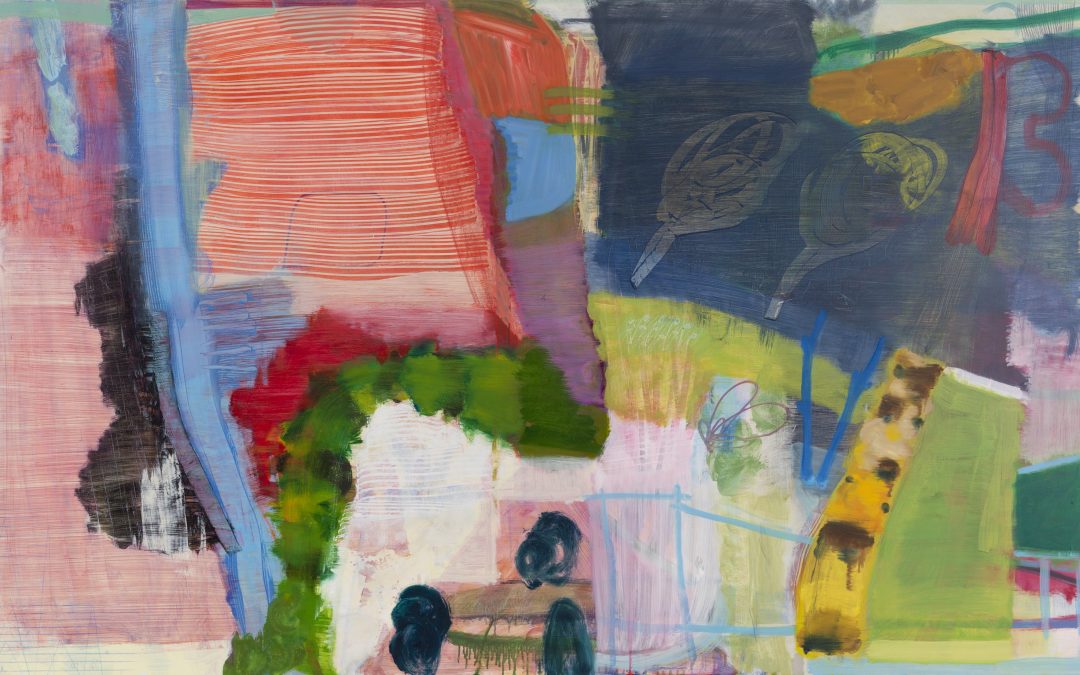
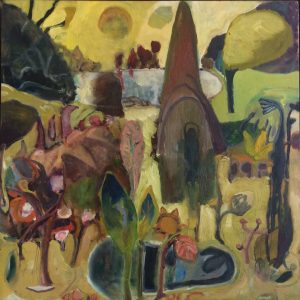
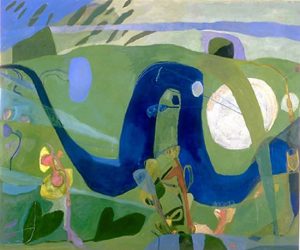
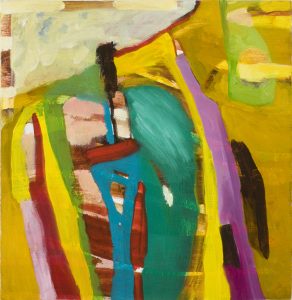
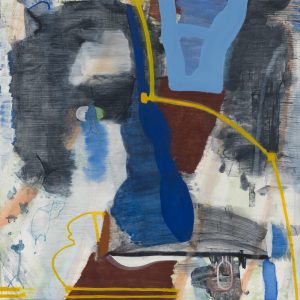
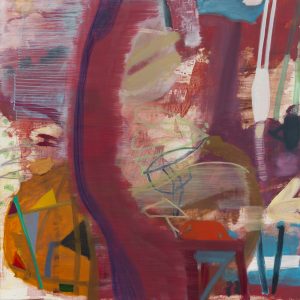
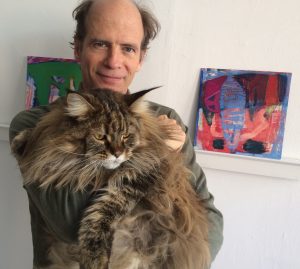
Thanks for introducing this ”’new to me artist” Ann. I love this work and the “complex little worlds” analogy of the small works. And that gorgeous cat, ♥!
I LIKEUM!!
~ So while at Harvard, did you, per chance, take art history classes from Michael Fried? ~
Oh, I remember him well…and one particular run-in, after I attending his lecture on Modern Art. In it, he brought the entire early 20th art developments down to Cubism. ~ Total myopia, in my opinion. ~
I was so flabbergasted, that afterwards I left him a note in his mail-box that said: “Have you ever considered that not everything that has 4 legs is necessary a dog?” ~ Somehow, he knew it was me who had left this note…he shrugged it off…obviously not amused! ~
~ Since I found you on FB, may I befriend you? ~ I like a lot of things about your ptgs! ~
Hi Inessa:
Michael Fried was no longer in the Art History Department when I was there. Just as well. I think that attitude you describe, in this case the notion that of modern art arises from a cubist foundation, suffers from historical determinism, in the Hegelian sense. Which is to say that mindset believed in historical change in one direction, toward the “new”. But the logic of the “new” being better in the field of the arts has never been shown with any clarity and causal certainty in my opinion. As much as human beings crave the new, we love going to museums to look at the old. And the “old” I like is from all societies, so called “primitive” to contemporary western..
Julian, wonderful article. Thanks for sharing.
To think, I knew you when you were in college! Tom
Tom: what a long strange trip it has been!
Thanks for the wonderful article, Ann. I love finding out about artists I’m not familiar with. His work is stunning and looks like it’s as powerful at 12″x12″ as at 42″ x 42″. Wish I could teleport myself to Elizabeth Harris to see his work in person!
Ann: Thank you for stringing together a meandering career trail in way that is very readable and enjoyable. And credit goes to Annabelle for adding a furry presence to the images. I especially hope other artists as well as art lovers get something out of your story and my work. Regarding the painting career, one element that can’t be underestimated is luck, and I have enjoyed more than my fair share in art and life in general. Painting as practiced in my “interpretive community” as Stanley Fish would put it, is such a strange and mysterious undertaking. After almost four decades of practice, I feel like I’m just getting a hand on the foot of the elephant, the elephant being the metaphor for what painting is.
I like this clear, down to earth story of a painter’s path to where he is on that path now. And the paintings, I like the paintings.
Thanks Ann.
Congratulations on this wonderful article. It is always nice to see Julian, and his work, getting support and exposure.
This is such a good experience to read and view, Julian. Throughout I found myself unwinding and rewinding the years. Looking forward to seeing the new work; you are always pushing the edges.
Julian, I am so proud and grateful to be your friend, Harvard classmate, and rowing buddy. Thank you so much for sending this. The paintings are beautiful and the writing is so interesting and engaging. The references to art history at Harvard remind me of the one-of-a-kind course called Monuments of Asia with the late Oleg Grabar. I’ll never forget all that he taught us about the intersections of faith, culture, art, and architecture in the ancient Middle East. It’s also fun to hear again about Fernando, a character who has come up frequently in our past conversations. Can’t wait to share this blog post and all the colorful eye candy with my loved ones and fellow art-lovers, including my wife, our son Nathanael, and my three big sisters. Come to think of it, I may also share it with our classmate Dave Calkins, who lives in the Bronxville area. Perhaps one or more of us will be able to come to your show in NYC next month, though that remains to be firmed up. BTW, there’s a terrific show of American watercolors at the Philadelphia Museum of Art, now through May. Hoping to see it for the first time this weekend when our son Nat, whom you have met, comes home for a spring visit. Yay!
Threshold… nice work: thank you for persistence and insistence to be a part of history.
Wonderful article and oh the work gets more and more delicious and profound!!! I love seeing the juxtaposition of earlier and later pieces. Hope the show goes incredibly well and so sorry we cant be there!
Thank you Kato, James, Don, Jack, Rob and Elaine, for your comments. One response I often get from my art talks, which are mostly a chronological walk thru my painting career, is a comment about honesty, as if listeners rarely enjoy or find this attitude or disposition in the deliverer of the art lecture. Perhaps some artists wear their “game face” all the time, or have something on their mind (ambition?) that gets in the way of speaking plainly. I do admire artists who wear a fabulous game face (David Bowie–Ziggie Stardust) but distinguish clearly between performance and person. I can riff in the jargon of Critical Theory and speculate about performativity like Judith Butler does, or on the ontology of “being an artist”. But I would leave most readers or listeners in the dust, wondering what I am talking about.
Was Zobel specifically talking about harvard’s studio classes?
Never understood why a school with the Fogg would be so awful with studio classes. Absolutely awful. Why didn’t you just go down the street to Mass Art or the museum school. They were great.
Zobel gave other advice such as, “painting and art are so demanding there really isn’t adequate time to see your projects grow and advance in a significant way relative to the other things Harvard has to offer. Liberal Arts colleges tend to be about ideas, so expose yourself to as many as you can. After college, if you still want to try a career in the arts, apply yourself then. ” I took drawing classes for credit and really enjoyed the art history. I transferred into the art history major half way thru sophomore year, so there wasn’t too much time before graduation.
Dean Jeremy Knowles did not seem sympathetic to the studio arts in my time. He wanted students to focus on more rigorous humanities and more science. Perhaps the neglect was intentional.
Is your cat a Norwegian forest cat? She looks like my Lucy. I’d love to see her in your paintings.